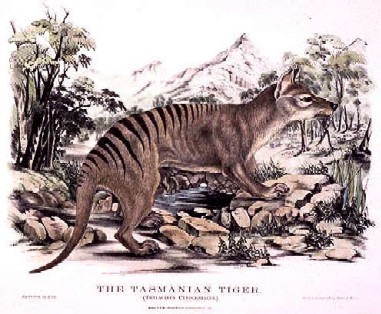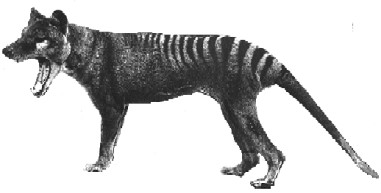Byron Bay Mystery Beast
Posted by: Craig Woolheater on March 21st, 2006
Aussie cryptozoologist Mike Williams, weighs in with a guest blog for Cryptomundo.
A mystery animal has been causing in Australia’s hippie capital, Byron Bay, leaving locals to speculate they may have a thylacine in their midst.

Builder Mick Stubbs and his wife Fabi first spotted the creature in early February at about 3 am as they drove along the old Pacific Highway, about 400m north of a place called Uncle Tom’s Pies.

Mullumbimby builder, Mick Stubbs is "1000 percent convinced" the animal he saw near Uncle Tom’s Pies wasn’t a dog or a dingo
At first the couple thought the animal was a fox, but an exceptionally long tail had them thinking otherwise.
Stubbs described the beast as “not a dingo or a dog of any kind”, and it had rounded ears and golden eyes, but none of the tell-tale stripes of the thylacine.
A sketch he later did, however, resembled that of a Tasmanian tiger.
Billinudgel Post Office owner Sue Stirton claims to have also seen the strange creature five years ago in the main street of her village, "I thought to myself, there are some sick people around, because it looked like a cross between a greyhound and a kangaroo".
The sighting has sparked a small storm of controversy in an area better known for its New Age lifestyle and illegal drug crops.
Raelene Mudge, of South Golden Beach, was driving along Shara Boulevarde about 11 pm a month ago when she saw a large animal on the road. Her first thought was, "My god, that feral cat is big."
Mullumbimby resident Barbara Eady reckons she saw a "creature from hell" about six months earlier along Brunswick Road, having just turned off the old Pacific Highway.
She told the Byron Shire News, "It had a strange-looking head – a very odd-looking animal." She added that the animal didn’t have flat fur and had looked a bit beaten up.
Another Mullumbimby local, Annette Deckmann, saw a strange animal about five or six months ago, also on Brunswick Road, this time near McAuley’s Lane, "I was straight away thinking of a Tasmanian tiger-greyhound mix. It had very short fur, but no stripes. The only animal I could think of was a Tasmanian tiger, but I was aware they are extinct. It was a dog-like creature, but not a dog. It was very strange."

About Craig Woolheater
Co-founder of Cryptomundo in 2005.
I have appeared in or contributed to the following TV programs, documentaries and films:
OLN's Mysterious Encounters: "Caddo Critter", Southern Fried Bigfoot, Travel Channel's Weird Travels: "Bigfoot", History Channel's MonsterQuest: "Swamp Stalker", The Wild Man of the Navidad, Destination America's Monsters and Mysteries in America: Texas Terror - Lake Worth Monster, Animal Planet's Finding Bigfoot: Return to Boggy Creek and Beast of the Bayou.









I don’t have that much to say about it except for that it wouldn’t be the first “extinct” animal that has been found over the years. I would love to hear that there were still tasmanian tigers around.
The extraterrestrials who experimented with DNA manipulation on this planet so long ago (?) sure had a lot of fun on the comparatively isolated islands in the southern hemisphere…
See here.
I love how you say that so matter of factly fuzzy. 😛
Could it be, not a tasmanian tiger, but the marsupial lion (thylacoleo carnifex) that people are spotting? (The tassie tigers been ‘extinct’ only ~70 years, far far longer on the mainland)
Illegal drug crops — people seeing strange animals — could there be a connection?
unlikely. too long between the sightings and if it was a hallucination, its odd for people to have a halluciation of the exact same thing over so long a time. I believe they are seeing something, just, not sure what at the tiem.
Hahaha – like your post Edward. However, in response to craddosk (3) – if you read Robert Paddle’s volume on the matter (The Last Tasmanian Tiger), there is significant evidence to suggest the thylacine was alive and well in Victoria and South Australia until the 1830s or 1840s.
Apart from the direct evidence, he draws an analogy with the Tasmanian Devil – for example, until the 1900s, there was only one credible naturalist testimony to the existance of the devil on mainland Australia – although admittedly in all of NSW, Vic and SA (but rare). However, in 1912 one was captured in Victoria. Since then, four more specimens have entered museum collections – the most recent 2 being roadkill in 1991 from locations 150km apart. In his words, “there would have to be a phenomenally high population of incompentent Victorian naturalists illegally keeping Tasmanian devils as pets, in order for as many as five of their lost captives to become museum specimens”. (pages 24, 25)
He researches the historical scientific evidence (as in documents, letters, etc) for the existence of the thylacine on Mainland Australia in the 1700s through to early 1800s – and, significantly, concludes that there was actually more documentation for the thylacine’s existence than the devil! Yet we have at least 5 devils preserved.
Anyway – a bit of a rant, and also a plug for a great book. But given what we think we know, but don’t, about animals that exist even today… keep an open mind about thylacines in “Australia’s hippie capital”!
Chris.
yea, ok. But i like the idea of a ‘Marsupial Lion’ wondering around than a ‘Marsupial wolf’ 😛
I remember a few years back (Not sure of exact date) they found a colony of quolls (cant remember exact species, western quoll maybe?) lurking around which were first thought to be extinct…. which does support the idea of predatorial Marsupials existing without mans awareness. I have read of the documented roadkills of the devils. Since the ol’ tassie tiger is a bit faster (more capible of avoiding cars) and probably more cunning than its little black cousin, then is possible…
but come on, ‘lions’ are cooler 😛
hahaha.. if you check out the footage of the thylacine at the online thylacine museum – there is one video which shows a man stooping down to look in the thylacine’s cage. The thylacine rears up on it’s hind legs and you get a good comparison of size (although we don’t know how big the man is)… Lion or not – a thylacine jumping up on me is something *I* don’t want to experience… unless I live to tell the tale! 🙂
I’m interested in your quoll info.. where did they find this colony? I believe the Eastern Quoll has been extinct in NSW since the 1960s – the last one being found dead on a road in Nielsen Park, Sydney (now the location of the National Parks and Wildlife Head Office – nice!)
I’d like to think they still exist in NSW. I think there may have been some sightings a little further north – I got this info from someone who spent time trapping and recording small mammals in the Central Coast area.
At least this species isn’t completely gone – it lives on, in Tassie no less. And NSW does have one remaining quoll species too.
Sorry – the mind’s a bit rusty on specifics at present – I haven’t read up on them for ages.
Yea, i cant remember the specifics sorry : I just remember it being on the news one day that they had rediscovered a species of quoll previously thought wiped out (maybe it was thought extinct ‘to a particular area’).
Either way, it proves the point that if these little critters can survive when thought to be ‘extinct’ (even if its only to one specific geographical location) then maybe others can as well (thylacine, devils on the mainland, etc).
Australia is a big place, with scarce human habitation. it *IS* possible 🙂
I’m with you on that!
I too tend to think that many of the mainland sightings are of Thylacoleo. Because of sometimes seeing a mystery creature having a striped coat, it is generally confused with the thylacine, but besides both animals looking somewhat alike, the stripes on the mystery animals are heavy on the front half of the animal. Sometimes they have no stripes, and are still compared to the thylacine. But the “lion” has a more cat-like appearance-though not totally. Not to take away from the fact that there maybe surviving mainland thylacines. From the cave find on the mainland of a preserved thylacine(mummified)we know that it looked just like the Tasmanian version. So animals that look like what Rilla Martin photographed in 1964 are not mainland thylacines-and in my opinion are thylacoleo. Yarri
In all honesty, I probably haven’t given the thylacoleo hypothesis the proper attention it deserves. Somehow it just seems too far fetched without even thinking about it. But that’s the problem – not spending the time to think about it.
I was looking at the Martin photograph the other day. The online thylacine museum caption for the photo notes the shape of the head – but to me the photo almost looks like a body without a head – the background is so distracting I can’t make out facial features.
The best I can come up with is that it’s a dog with makeup on – the eye (if it is the eye) appears to me like a photographic negative – being white where you’d expect dark, and then looking like there are three white eyelashes painted on. Totally confused on that one.
One other thing I’d love to know – with so many environmental stats flying around about how 90% of our forests have been axed, 80% of this habitat, 95% of that (I’m not quoting real figures here) – I ask – where on earth is there for these large animals to still live? And never provide a modern corpse or skeleton? It’s easy to say “it’s a big, underpopulated country”, but….
Some of the Byron Bay sightings (within 100km) are in locations of bush which are maybe 20 km long, 8km wide and bounded by the sea and the country’s largest highway… It seem very very very unlikely to me that the thylacine could maintain a breeding population there unnoticed for 200 years – well at least as long as the highway has been there.
Does anyone have links to hard data from BIOCLIM relating to thylacines? Or a map showing sighting locations, and density (ie larger dot on the map equals higher number of sightings – or more recent sightings, etc)…
If the comments section of a single cryptomundo post is the wrong spot for this discussion, let’s pick it up in an appropriate forum.. I don’t mean to hijack the comments by getting so off topic… but then, maybe the blogsters here are happy to see such dialogue occuring?
Chris.
The first link in this article (to Mike Williams) links to the website Alien Nation.
There is an article there suggesting the sighting might have been a farmer’s dog.
Actually that would be STRANGE Nation…I believe Alien Nation was a rather bad TV serial about, well, aliens 🙂
Re: quolls – in the Blue Mountains of NSW the tiger quoll (the larger and more aggressive of the two) is alive and well, albeit endangered. Anyone who owns chickens can no doubt relate a story of losing a few to the ferocious native cats. There’s also a guy breeding the eastern quolls in Lithgow, NSW – not sure if it’s with a view to releasing them. I’m sure there are a few still running around the place. I almost hit one in the car when I was down in Tassie a few years back – it was the first time I had ever seen one in the flesh and I remember thinking at the time how comical they looked with their white polka dot spots 🙂
yes – corrected – STRANGE nation, not alien!
Ditto the Tassie/car/Eastern Quoll experience. I know about the breeding program in Lithgow, but as far as I know, the Eastern Quoll is considered extinct on mainland. (Which is not to say it necessarily is, of course!)
Chris.
Anyone else in here an ecological and paleontological info storage type person? You know, someone who knows alot about it.
Thylacoleo was(is?) larger than the thylacine, or at least the modern species. There were several species of thylacine, the current one being one of the comparative midgets. The largest was about 20 ft and had a different body form.
Nowhere near 80% has been axed, and, with a more environmentally conscious world, the continued existance of much of our biodiversity is assured.
Until I can get a better site, my crypto blog is located at http://www.xanga.com, and is titled CryptoInformant_007.
CryptoInformant (16) asks if anyone else is “an ecological and paleontological info storage type person” before commenting on the 80% forest axing referred to in my previous comment (12) which I described as “not quoting real figures”.
I only hope s/he didn’t have me in mind!
Nevertheless, the response is a good one – and a challange at that; what indeed was in my mind when I had this vague notion that 80 – 95% of various types of habitat had been destroyed?
A quick search of the Australian Government website for the Department of Agriculture, Fisheries and Forestry produces the following observation from the “Land cover change in Australia” report (2000) (ftp://ftp.brs.gov.au/outgoing/longterm/lw/lcc_report.pdf)
“Clearing and extensive thinning of woody vegetation have meant that by the 1980s only five percent of the continent remained forested, and the area of woodland had decreased from 21 to 14 percent.”
So, quite correctly, not 95% of the woodland has been cleared – only about 33%, but on the other hand, only 5% of the continent remains forested – so I guess pre European colonisation would have the continent with about 7% woodland cover.
My guess is I fell victim to some political campaign at some point, which presented the statistics in such a way as to say “only 5% of our country remains forested” – gasp.
Thank you for helping me set this record straight for the general viewing public at cryptomundo.com!
Chris.
I saw an animal last night, that I believe to be a Thylacine, out from Mullumbimby. Whom do I talk with to lodge the details.
Rich,
I have forwarded your information to Mike Williams, Ruby Lang and Paul Cropper.
Rich–can you tell us more about your sighting? Anything you could post here would be great. These recent sightings continue to keep hope high that the thylacine is still alive and thriving.
Uh # 17? He, definitely a he. And you’re welcome. I actually thought that you meant that 80% of the world’s forests had been axed at first, and am glad it has been cleared up.
ditto! 😀